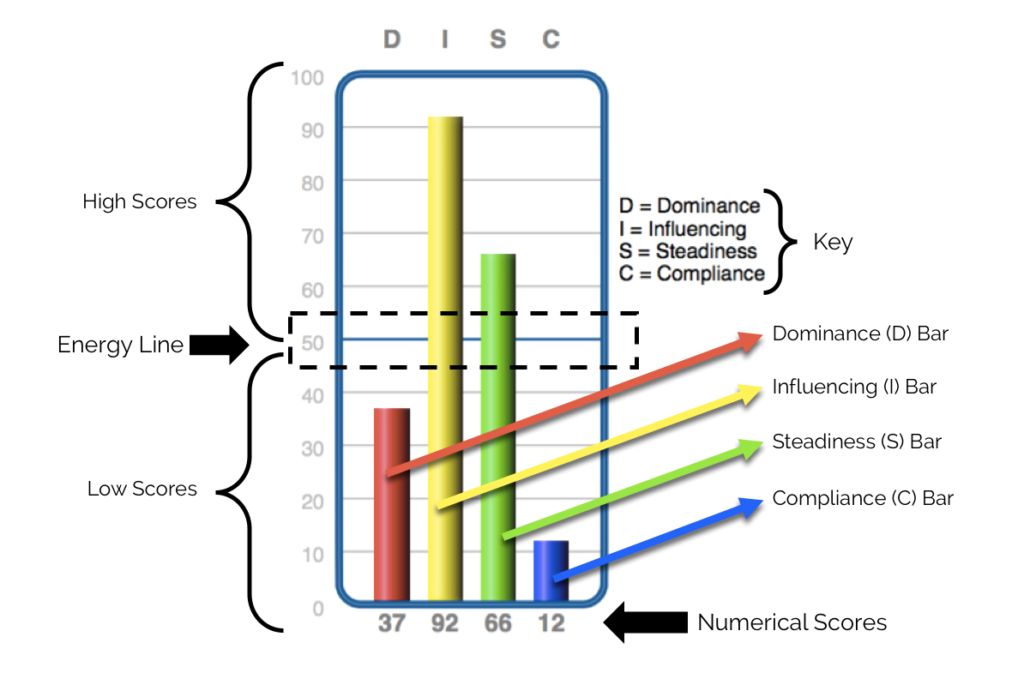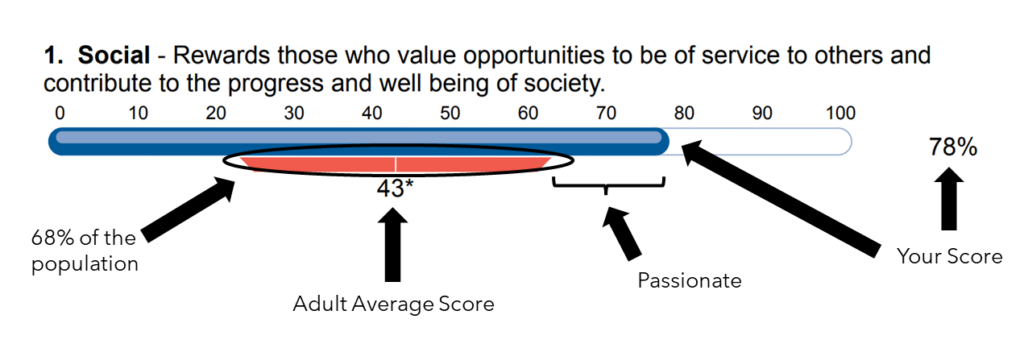Indigo Video Library
Understanding Your Indigo Report
DISC/Behaviors
Introduction to DISC
The DISC graph describes how a person tends to behave naturally in non-stressful conditions. There is no “correct” score to have. Each personal style is a unique blend of D, I, S and C. Scores indicate which behaviors come naturally to you and what environments bring out the best in you.
Reading the DISC Graph
To read the graph start with the red “D” bar on the left and end with the blue “C” bar on the right. Each of the DISC scores fall somewhere between 0-100, and are indicated by a colored bar, with the numerical score listed underneath. Any scores above 50 are considered high, and any scores under 50 are considered low. The scores furthest away from 50 are the most pronounced behavioral traits for a person (“High” or “Low”). Scores near 50 means that the person’s style in the given category tends to be more moderate, allowing them to adapt to different styles. For example, someone with 95 Dominance will be energized by highly competitive, fast paced environments, and a person with 5 Dominance will be very drained by the same scenario. Because of this, the “50” line is called the Energy Line.

Dominance
Dominance, or “D”, is about how you respond to problems. Someone who is High D is likely more direct, blunt, focused on results, and into challenge and competition. Someone who is Low D is likely more deliberate and thoughtful, and prefers peaceful settings. If your D score is below 50, watch the Low Dominance video. If your D score is above 50, watch the High Dominance video.
Influencing
Influence, or “I”, is about how you respond to people. Someone who is High I is likely friendly, talkative, enthusiastic, and likes to be around people. Someone who is Low I is more likely to be reflective, quiet, focused, and reserved. If your I score is below 50, watch the Low Influencing video. If your I score is above 50, watch the High Influencing video.
Steadiness
Steadiness, or “S”, is about how you respond to pace. Someone who is High S is likely loyal, patient, supportive of others, and likes consistency and planning. Someone who is Low S is likely flexible, active, spontaneous, and likes variety. If your S score is below 50, watch the Low Steadiness video. If your S score is above 50, watch the High Steadiness video.
Compliance
Compliance, or “C”, is about how you respond to process. Someone who is High C is likely logical, cautious, focused on details, and likes step-by-step processes. Someone who is Low C is likely independent, innovative, a big-picture thinker, and a risk-taker. If your C score is below 50, watch the Low Compliance video. If your C score is above 50, watch the High Compliance video.
Bridge
Bridges are people with all four of their their DISC scores between 30 and 70. They are adaptable and can thrive in different environments. Watch the video to the right to learn more about bridges.
Motivators
The Six Motivators
Aesthetic ~ Individualistic ~ Social ~ Theoretical ~ Traditional ~ Utilitarian
Indigo uses motivators to identify your “Why.” Motivators reveal the things you really care about. They are what makes you want to learn, what grabs your heart, and what gets you excited. If someone ignores or dismisses your top motivators you may feel hurt and disengaged. Motivators are important for major and career choice since motivators correlate directly to fulfillment and meaning.
Reading the Motivator Chart

Focus on your top two motivators. Notice where your score falls above or below the smaller bar (68% of population). This reveals areas where your motivators may be outside the mainstream and could lead to passion or conflict. The further a score rises above mainstream, the more you may feel passionate about that motivator.
Aesthetic
Desire for form, harmony, balance, or beauty.
People who have a high Aesthetic Motivator appreciate nature and beauty in the world. They are typically artistic and seek balance in their lives. High Aesthetics are greatly affected by their physical environment. The atmosphere or appearance of a school or workplace can even affect their grades or performance at work.
Individualistic
Desire for independence, recognition, or power.
People who have a high Individualistic Motivator want to be in control of their own future and frequently seek personal recognition and power. Instead of being told what to do, they want choices. They need to make sure they have freedom and choice in their career.
Social
Desire to help others or solve society’s problems.
People who have a high Social Motivator are altruistic and love to help people or a cause they care about. Their core question in life is typically, “What is my cause?” If they understand how their education will help them help others, they become much more engaged in academics. If you are a High Social, it’s important for you to figure out where you want to give back and how you can make a difference.
Theoretical
Desire to learn for the sake of knowledge.
People who have a high Theoretical Motivator love learning for the sake of learning and exploring their favorite topics deeply. If you are High Theoretical, you might run the risk of going so deep in an interest area that you lose interest in other topics. If that is the case, find a more specialized educational program or job that allows you to dedicate more time to go as deep as possible in your specialty.
Traditional
Desire to live by a personal set of principles or beliefs.
People who have a high Traditional Motivator value traditions, are driven by strong beliefs (which could be family, cultural, religious, military, self-determined, or something else), and follow their principles. If you have this motivator, look for opportunities that validate and/or allow you to share your beliefs. Look for employers that align with your way of living.
Utilitarian
Desire for a return on investment of time, energy, or money.
People who have a high Utilitarian Motivator seek practical returns for their efforts, tend to be money motivated, and value efficiency. They tend to be least served in most school environments, because Utilitarian is often the last motivator of educators. Keeping this in mind, if you are High Utilitarian, it’s important you make sure the program/major you choose helps you to achieve your personal goals as quickly as possible.
Skills
The Indigo Report lists 23 skills that are important in the world of work. The key to success is using your strengths while minimizing your weaknesses. Plus, you can grow more in areas where you already have natural talent. When looking at the skills list, think of the skills at the top as the ones that come more naturally to you, thus requiring less energy on your part. Watch at least three videos based on your top five skills.
